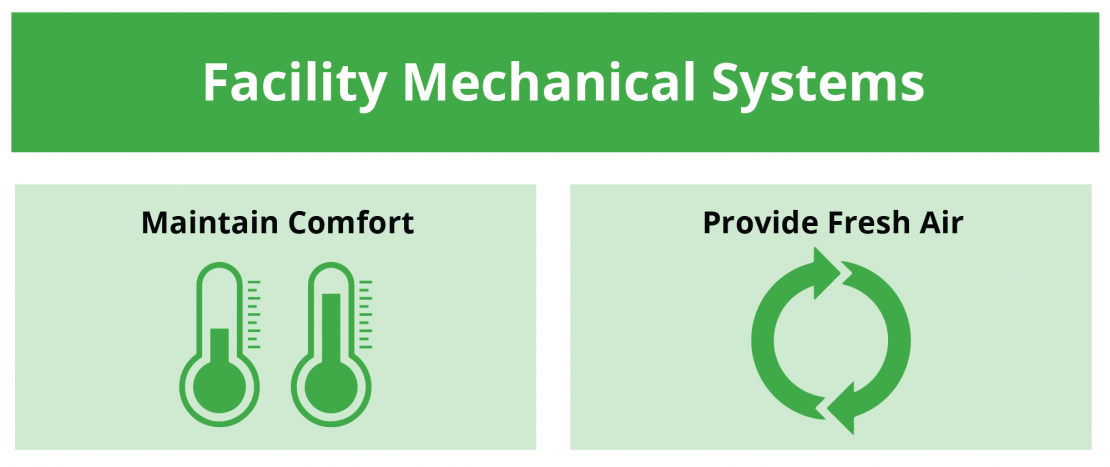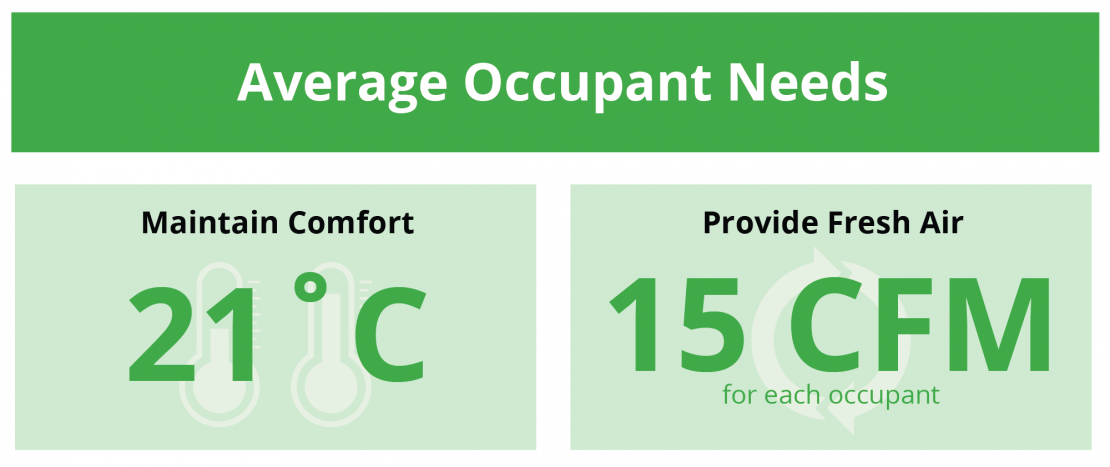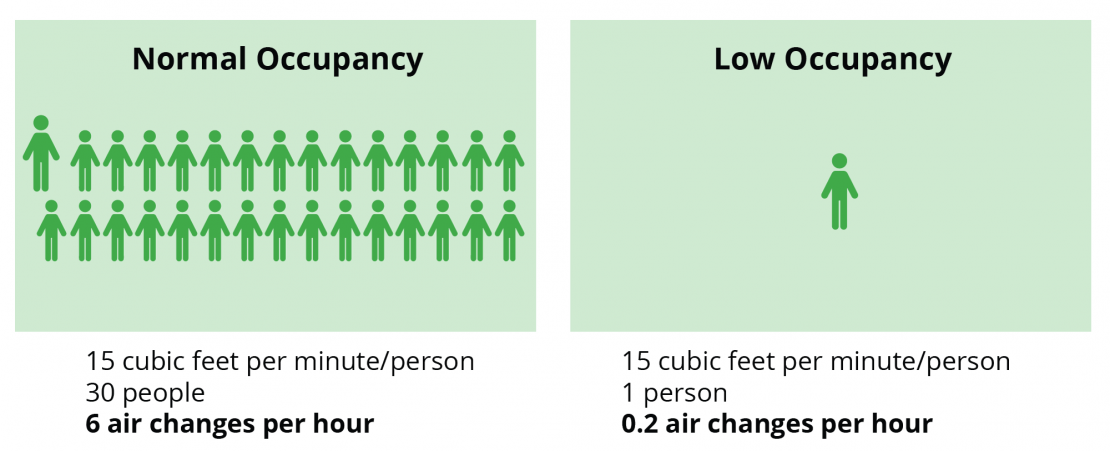Building automation programs in schools tend to be binary: there is one setting for when the facility is completely full and another setting for when it is empty.
It is rare to find a building automation system (BAS) that has a program to automate energy use for skeleton occupancy, such as when just the staff are in the facility. This setting is ideal for professional development days, and it is the optimal schedule for the class cancellations from the COVID-19 outbreak.
A BAS strategy for schools with low occupancy is an opportunity to reduce energy use and costs for any day when only the staff are in the facility.
How mechanical systems normally operate
There are two main objectives of a facility’s mechanical system:
- Maintain comfort.
- Provide fresh air for breathing.

Comfort is maintained by keeping the building at an optimal temperature, which in Canada usually means making up heat losses by injecting heat into the facility (although cooling can be important during the start and finish of school years). The goal of radiators, unit heaters and forced flow units is to offset the heat that is lost through windows and walls, mechanical spaces and entry points.
To ensure the facility has sufficient fresh air, outdoor air is injected into the existing air in the building. This is the job of central air handling units, unit ventilators, furnaces and similar equipment.
If the building was designed for optimal energy consumption, maintaining comfort and ventilation are seen as two discrete objectives. That is, the ventilation system is not responsible for maintaining comfort (and vice versa).
Regular operation of mechanical systems
Mechanical systems in most school facilities are operated by building automation systems (BAS). The BAS coordinates heat loss and ventilation during occupied and unoccupied times.
When the school is occupied, the BAS runs the heat loss systems with the ventilation systems to maintain both comfort and air quality.
When the school is unoccupied, the BAS only maintains heat loss – ventilation systems are turned off completely or the air inside the building is recycles through its heating coil (so no new outdoor air is introduced into the facility). It is common for BAS systems to maintain lower temperature setpoints when the building is unoccupied in order to conserve energy, but the facility still needs to maintain some level of heating.
It’s either on or off
The BAS of most schools is set for full occupancy (by maintaining comfort and ventilation) or zero occupancy (by turning off ventilation and maintaining a relaxed temperature setpoint). It’s either all on or all off.
There are very few schools that we’ve come across that have an automated control mode that provides comfort and ventilation for low occupancy, such as when just the teachers are in the building. The exception are facilities with demand-controlled ventilation systems that automatically regulate ventilation. Although it is ideal, it is not the norm.
Average occupant needs
Humans need ambient air temperature of 21˚C (or within a few degrees of that target).
For ventilation, humans need outdoor air ventilation rates of 15 cubic feet per minute according to building codes (ASHRAE 62.1). Every individual requires 15 cubic feet per minute, so ventilation demands depend on the number of people in a room.

Operation under low occupancy
The comfort and ventilation requirements of a school varies with the facility’s occupancy and what rooms are being used.
Managing comfort is straightforward: an air temperature of around 21˚C needs to be maintained in rooms that are being used. If a room is unoccupied, the temperature target does not need to be maintained. On low occupancy days, some rooms may not be occupied (such as gyms, libraries, computer rooms, multipurpose room) so these rooms can have relaxed setpoints.
Ventilation is dependent on the number of individuals in each room. Here’s an example of a standard classroom:
On normal school days, a classroom has 30 occupants so requires six air changes per hour (ACH) to meet the ASHRAE standards. The air in a full classroom must be recharged six times in one hour. A single occupant in that classroom requires 1/30th ACH, so 0.2 ACH per person. When that same classroom is only occupied by the teacher, the air must be recharged only once every five hours.
For a standard classroom, the ventilation requirements drop from six recharges every hour to just one recharge per day.

BAS strategy for low occupancy
To summarize, the standard comfort and ventilation requirements of a facility are:
- Maintain a temperature around 21˚C in every occupied room.
- Ensure there is 15 cubic feet per minute of fresh air for every individual in the occupied rooms.
Here are our suggestions to achieve comfort and ventilation under low occupancy situations.
Identify which systems ventilate which spaces
Determine the ventilation systems that are responsible for ventilation of specific spaces or zones of the school. If needed, use the BAS map to identify the systems for each space.
Identify space ventilation needs
Categorize spaces into three types, based on occupancy:
- High density spaces: Areas that should have normal comfort and ventilation, such as admin offices.
- Empty rooms: Areas that should be set to the unoccupied mode, so with no ventilation and relaxed temperature setpoints.
- Low density spaces: Areas that have reduced number of occupants, such as classrooms that are occupied by one teacher.
This categorization assumes that there is a dedicated ventilation system for every identified space or group of spaces zoned within a central ventilation system. That is ideal but not always possible.
Create a new occupancy mode for your BAS
For low density spaces, apply the following settings in your BAS:
- Set the fan schedule to run on 15-minute intervals every two hours, then off for the remainder
- Set default space temperature to 21˚C.
You can call this occupancy mode “Pro D Day” – then reuse it for future days when only the staff are in the facility.
Apply this new mode to the low-density spaces and replace the current “Occupied Mode” setting.
Apply the new occupancy mode system-by-system
In many cases, there will be unoccupied spaces within a ventilation service area shared with low density spaces. Here are our suggestions for these zones:
- Apply the new occupancy mode.
- Reduce the overall ventilation runtime in proportion to the area of unoccupied rooms to low-density rooms. Empty rooms contribute fresh air through the return air system pathways, so this reduces the overall requirement for outdoor air.
- For unoccupied rooms, use the BAS manual override to set the temperature to between 16 and 18˚C.
Empty spaces are still ventilated (but much less than before) and their temperature setpoints are relaxed.
Some caveats of this strategy
Every school is different, so a universal strategy will not be applicable for every facility. Here are some caveats for this low occupancy BAS strategy:
- Some schools were designed without perimeter radiation systems, meaning ventilation systems also provide comfort setpoints.
- This strategy is geared towards facilities that have central ventilation systems of about 10,000 cubic feet per minute with 10% outdoor air. Larger systems will require different calculations.
Optimizing a facility’s BAS is best done by reviewing the data, but these recommendations will help most schools to save energy when only the staff are in the facility.
Save energy with a low occupancy mode
After the low occupancy mode is set up, it can be enabled for any day when just the staff are in the facility.
Ventilation is responsible for around 40% of the fuel energy costs and 20 to 40% of the electrical costs in an average school. By reducing ventilation (in addition to reducing some heating demands), your facility will consume less fuel and electricity.
When a classroom goes from 30 individuals to just one, the ventilation requirements are reduced by a factor of 30. In some cases, the existing indoor air may be sufficient to maintain adequate ventilation during low occupancy – so ventilation systems may not even be required.
It’s possible to cut ventilation rates and run times by half (or even more) on low occupancy days. For the class cancellations during the COVID-19 outbreak, this can result in substantial cost savings.
These recommendations are broad guidelines based on the typical equipment in an average facility, and they should not be construed as professional engineering advice. Please consult with Rede or another engineering professional before implementing changes.
